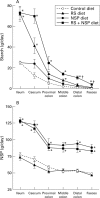Wheat bran affects the site of fermentation of resistant starch and luminal indexes related to colon cancer risk: a study in pigs
- PMID: 10562582
- PMCID: PMC1727739
- DOI: 10.1136/gut.45.6.840
Wheat bran affects the site of fermentation of resistant starch and luminal indexes related to colon cancer risk: a study in pigs
Abstract
Background: Recent studies suggest that resistant starch (effective in producing butyrate and lowering possibly toxic ammonia) is rapidly fermented in the proximal colon; the distal colon especially would, however, benefit from these properties of resistant starch.
Aims: To determine whether wheat bran (a rich source of insoluble non-starch polysaccharides), known to hasten gastrointestinal transit, could carry resistant starch through to the distal colon and thus shift its site of fermentation.
Methods: Twenty four pigs were fed four human type diets: a control diet, or control diet supplemented with resistant starch, wheat bran, or both. Intestinal contents and faeces were collected after two weeks.
Results: Without wheat bran, resistant starch was rapidly fermented in the caecum and proximal colon. Supplementation with wheat bran inhibited the caecal fermentation of resistant starch, resulting in an almost twofold increase (from 12.9 (2.5) to 20.5 (2.1) g/day, p<0.05) in resistant starch being fermented between the proximal colon and faeces. This resulted in higher butyrate (133%, p<0.05) and lower ammonia (81%, p<0.05) concentrations in the distal colonic regions.
Conclusions: Wheat bran can shift the fermentation of resistant starch further distally, thereby improving the luminal conditions in the distal colonic regions where tumours most commonly occur. Therefore, the combined consumption of resistant starch and insoluble non-starch polysaccharides may contribute to the dietary modulation of colon cancer risk.
Figures





References
Publication types
MeSH terms
Substances
LinkOut - more resources
Full Text Sources
Medical
